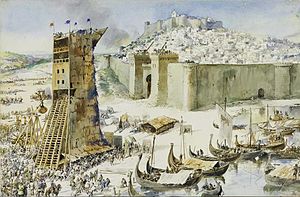
Back Beleëring Afrikaans Setio AN حصار Arabic حصار عسكرى ARZ Asediu AST Mühasirə Azerbaijani Аблога Byelorussian Обсада Bulgarian Opsada BS Setge Catalan

| Part of a series on |
| War |
|---|
A siege (Latin: sedere, lit. 'to sit')[1] is a military blockade of a city, or fortress, with the intent of conquering by attrition, or by well-prepared assault. Siege warfare (also called siegecraft or poliorcetics) is a form of constant, low-intensity conflict characterized by one party holding a strong, static, defensive position. Consequently, an opportunity for negotiation between combatants is common, as proximity and fluctuating advantage can encourage diplomacy.
A siege occurs when an attacker encounters a city or fortress that cannot be easily taken by a quick assault, and which refuses to surrender. Sieges involve surrounding the target to block provision of supplies and reinforcement or escape of troops (a tactic known as "investment"[2]). This is typically coupled with attempts to reduce the fortifications by means of siege engines, artillery bombardment, mining (also known as sapping), or the use of deception or treachery to bypass defenses.
Failing a military outcome, sieges can often be decided by starvation, thirst, or disease, which can afflict either the attacker or defender. This form of siege, though, can take many months or even years, depending upon the size of the stores of food the fortified position holds. The attacking force can circumvallate the besieged place, which is to build a line of earth-works, consisting of a rampart and trench, surrounding it. During the process of circumvallation, the attacking force can be set upon by another force, an ally of the besieged place, due to the lengthy amount of time required to force it to capitulate. A defensive ring of forts outside the ring of circumvallated forts, called contravallation, is also sometimes used to defend the attackers from outside.

Ancient cities in the Middle East show archaeological evidence of fortified city walls. During the Warring States period of ancient China, there is both textual and archaeological evidence of prolonged sieges and siege machinery used against the defenders of city walls. Siege machinery was also a tradition of the ancient Greco-Roman world. During the Renaissance and the early modern period, siege warfare dominated the conduct of war in Europe. Leonardo da Vinci gained some of his renown from design of fortifications. Medieval campaigns were generally designed around a succession of sieges. In the Napoleonic era, increasing use of ever more powerful cannons reduced the value of fortifications. In the 20th century, the significance of the classical siege declined. With the advent of mobile warfare, a single fortified stronghold is no longer as decisive as it once was. While traditional sieges do still occur, they are not as common as they once were due to changes in modes of battle, principally the ease by which huge volumes of destructive power can be directed onto a static target. Modern sieges are more commonly the result of smaller hostage, militant, or extreme resisting arrest situations.
- ^ "Definition of SIEGE". www.merriam-webster.com. 15 June 2023.
- ^ "Definition of INVEST". www.merriam-webster.com. 10 June 2023.